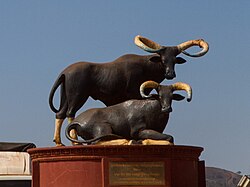Kouprey
The kouprey (Bos sauveli), also known as the forest ox and grey ox, is a possibly extinct species of forest-dwelling wild bovine native to Southeast Asia. It was first scientifically described in 1937. The name kouprey is derived from the Khmer language and means "forest ox".[4]
| Kouprey | |
|---|---|
| File:Kouprey at Paris Zoological Gardens in 1937 (Colored).jpg | |
| The holotype specimen, a young bull at the Paris Zoological Park, 1937 | |
| Conservation status | |
| Scientific classification | |
| Kingdom: | Animalia |
| Phylum: | Chordata |
| Order: | Artiodactyla |
| Family: | Bovidae |
| Genus: | Bos |
| Species: | B. sauveli
|
| Binomial name | |
| Bos sauveli Urbain, 1937
| |

| |
| Geographic range | |
| Synonyms | |
|
Bos (Bibos) sauveli (Urbain, 1937)[3] | |
The kouprey is listed as Critically Endangered and possibly extinct on the IUCN Red List.[2] The last confirmed sighting of a wild individual took place in 1969.[5]
- ↑ Suraprasit, K.; Jaegar, J.-J.; Chaimanee, Y.; Chavasseau, O.; Yamee, C.; Tian, P.; S. Panha (2016). "The Middle Pleistocene vertebrate fauna from Khok Sung (Nakhon Ratchasima, Thailand): biochronological and paleobiogeographical implications". ZooKeys (613): 1–157. Bibcode:2016ZooK..613....1S. doi:10.3897/zookeys.613.8309. PMC 5027644. PMID 27667928.
- ↑ 2.0 2.1 2.2 Timmins, R.J.; Burton, J. & Hedges, S. (2016). "Bos sauveli". IUCN Red List of Threatened Species. IUCN. 2016: e.T2890A46363360. doi:10.2305/IUCN.UK.2016-2.RLTS.T2890A46363360.en. Retrieved 18 November 2021.
- ↑ Urbain, A. (1939). "Note complémentaire sur le Bæuf sauvage du Cambodge (Bos (Bibos) Sauveli Urbain)". Bulletin du Muséum national d'histoire naturelle. 2. 11 (6): 519–520.
- ↑ "Kouprey". www.wwf.org.kh. Retrieved 2023-06-21.
- ↑
Kouprey Media
A statue of two kouprey bulls, located in Mondulkiri Province, Cambodia.
Oon, A. (2022). "Politics of Extinction: On the trail of Cambodia's kouprey". Southeast Asia Globe. Retrieved 2023-06-21.


